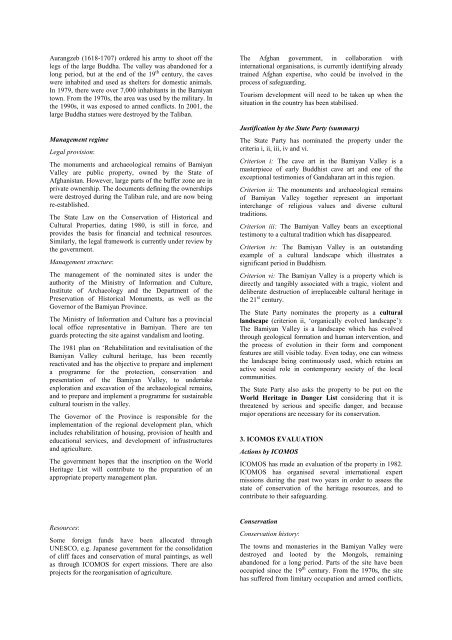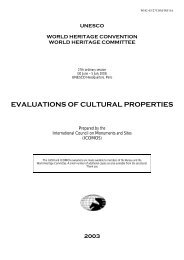evaluations of cultural properties - UNESCO: World Heritage
evaluations of cultural properties - UNESCO: World Heritage
evaluations of cultural properties - UNESCO: World Heritage
You also want an ePaper? Increase the reach of your titles
YUMPU automatically turns print PDFs into web optimized ePapers that Google loves.
Aurangzeb (1618-1707) ordered his army to shoot <strong>of</strong>f the<br />
legs <strong>of</strong> the large Buddha. The valley was abandoned for a<br />
long period, but at the end <strong>of</strong> the 19 th century, the caves<br />
were inhabited and used as shelters for domestic animals.<br />
In 1979, there were over 7,000 inhabitants in the Bamiyan<br />
town. From the 1970s, the area was used by the military. In<br />
the 1990s, it was exposed to armed conflicts. In 2001, the<br />
large Buddha statues were destroyed by the Taliban.<br />
Management regime<br />
Legal provision:<br />
The monuments and archaeological remains <strong>of</strong> Bamiyan<br />
Valley are public property, owned by the State <strong>of</strong><br />
Afghanistan. However, large parts <strong>of</strong> the buffer zone are in<br />
private ownership. The documents defining the ownerships<br />
were destroyed during the Taliban rule, and are now being<br />
re-established.<br />
The State Law on the Conservation <strong>of</strong> Historical and<br />
Cultural Properties, dating 1980, is still in force, and<br />
provides the basis for financial and technical resources.<br />
Similarly, the legal framework is currently under review by<br />
the government.<br />
Management structure:<br />
The management <strong>of</strong> the nominated sites is under the<br />
authority <strong>of</strong> the Ministry <strong>of</strong> Information and Culture,<br />
Institute <strong>of</strong> Archaeology and the Department <strong>of</strong> the<br />
Preservation <strong>of</strong> Historical Monuments, as well as the<br />
Governor <strong>of</strong> the Bamiyan Province.<br />
The Ministry <strong>of</strong> Information and Culture has a provincial<br />
local <strong>of</strong>fice representative in Bamiyan. There are ten<br />
guards protecting the site against vandalism and looting.<br />
The 1981 plan on ‘Rehabilitation and revitalisation <strong>of</strong> the<br />
Bamiyan Valley <strong>cultural</strong> heritage, has been recently<br />
reactivated and has the objective to prepare and implement<br />
a programme for the protection, conservation and<br />
presentation <strong>of</strong> the Bamiyan Valley, to undertake<br />
exploration and excavation <strong>of</strong> the archaeological remains,<br />
and to prepare and implement a programme for sustainable<br />
<strong>cultural</strong> tourism in the valley.<br />
The Governor <strong>of</strong> the Province is responsible for the<br />
implementation <strong>of</strong> the regional development plan, which<br />
includes rehabilitation <strong>of</strong> housing, provision <strong>of</strong> health and<br />
educational services, and development <strong>of</strong> infrastructures<br />
and agriculture.<br />
The government hopes that the inscription on the <strong>World</strong><br />
<strong>Heritage</strong> List will contribute to the preparation <strong>of</strong> an<br />
appropriate property management plan.<br />
Resources:<br />
Some foreign funds have been allocated through<br />
<strong>UNESCO</strong>, e.g. Japanese government for the consolidation<br />
<strong>of</strong> cliff faces and conservation <strong>of</strong> mural paintings, as well<br />
as through ICOMOS for expert missions. There are also<br />
projects for the reorganisation <strong>of</strong> agriculture.<br />
The Afghan government, in collaboration with<br />
international organisations, is currently identifying already<br />
trained Afghan expertise, who could be involved in the<br />
process <strong>of</strong> safeguarding.<br />
Tourism development will need to be taken up when the<br />
situation in the country has been stabilised.<br />
Justification by the State Party (summary)<br />
The State Party has nominated the property under the<br />
criteria i, ii, iii, iv and vi.<br />
Criterion i: The cave art in the Bamiyan Valley is a<br />
masterpiece <strong>of</strong> early Buddhist cave art and one <strong>of</strong> the<br />
exceptional testimonies <strong>of</strong> Gandaharan art in this region.<br />
Criterion ii: The monuments and archaeological remains<br />
<strong>of</strong> Bamiyan Valley together represent an important<br />
interchange <strong>of</strong> religious values and diverse <strong>cultural</strong><br />
traditions.<br />
Criterion iii: The Bamiyan Valley bears an exceptional<br />
testimony to a <strong>cultural</strong> tradition which has disappeared.<br />
Criterion iv: The Bamiyan Valley is an outstanding<br />
example <strong>of</strong> a <strong>cultural</strong> landscape which illustrates a<br />
significant period in Buddhism.<br />
Criterion vi: The Bamiyan Valley is a property which is<br />
directly and tangibly associated with a tragic, violent and<br />
deliberate destruction <strong>of</strong> irreplaceable <strong>cultural</strong> heritage in<br />
the 21 st century.<br />
The State Party nominates the property as a <strong>cultural</strong><br />
landscape (criterion ii, ‘organically evolved landscape’):<br />
The Bamiyan Valley is a landscape which has evolved<br />
through geological formation and human intervention, and<br />
the process <strong>of</strong> evolution in their form and component<br />
features are still visible today. Even today, one can witness<br />
the landscape being continuously used, which retains an<br />
active social role in contemporary society <strong>of</strong> the local<br />
communities.<br />
The State Party also asks the property to be put on the<br />
<strong>World</strong> <strong>Heritage</strong> in Danger List considering that it is<br />
threatened by serious and specific danger, and because<br />
major operations are necessary for its conservation.<br />
3. ICOMOS EVALUATION<br />
Actions by ICOMOS<br />
ICOMOS has made an evaluation <strong>of</strong> the property in 1982.<br />
ICOMOS has organised several international expert<br />
missions during the past two years in order to assess the<br />
state <strong>of</strong> conservation <strong>of</strong> the heritage resources, and to<br />
contribute to their safeguarding.<br />
Conservation<br />
Conservation history:<br />
The towns and monasteries in the Bamiyan Valley were<br />
destroyed and looted by the Mongols, remaining<br />
abandoned for a long period. Parts <strong>of</strong> the site have been<br />
occupied since the 19 th century. From the 1970s, the site<br />
has suffered from limitary occupation and armed conflicts,






